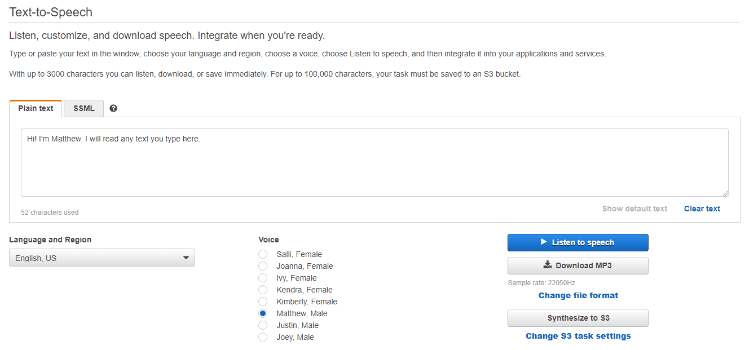
At that stage, it might no longer become so easy to discern when you’re listening to a machine read aloud to you, or a real human being. In a few years, the technology will probably leap forward massively thanks to machine learning applications. To sum it up, there’s still a lot of variation in quality when it comes to text-to-speech software. However, increasing the speed of the reader does a decent job of masking these issues. Speech sounds much more mechanical and the pauses between words are more noticeable. The difference in quality between Natural Reader and Amazon is obvious. Here’s a quick introduction video using some of the voices featured by the software: This program enables you to open and edit your documents, as well as paste content and have it read aloud to you in over 50 different voices. Naturally, there is plenty of other software offering decent text-to-speech capabilities, such as Natural Reader. Plus, your computer narrator will never tire or slur their words, which gives it an edge over humans. However, it’s not out of the question for someone to work through an entire book using text-to-speech and still enjoy it. The difference between what a human would sound like reading the text is noticeable. Admittedly, they’re all a bit stilted, but the Englishman’s rendition in particular is quite enjoyable to hear. You’ll notice the video showcases several voices, some of which sound better than you’d imagine. Here’s a quick example of Amazon Kindle’s text-to-speech functionality in action, reading Pride and Prejudice:

AMAZON TEXT TO SPEECH FREE SOFTWARE
However, this type of software has come a long way during the past few years. If you remember what text-to-speech software sounded like even a few years ago, you may not look on the technology fondly. The Current State of Text-to-Speech Software Recording human speech and reproducing is only the beginning, which brings us to the next section. Text-to-speech software enables you to listen to any written content you want as long (as the functionality is built-in).įrom a technical perspective, getting text-to-speech right is much more difficult than you might imagine. However, the same doesn’t hold true for most other written content, including articles, poems, and more. These days, most popular books are also released in audio format. For situations where audio versions of content aren’t available.

Even if your eyesight is perfect, sometimes it’s more comfortable or convenient to listen to something instead of reading it.

To some people, text-to-speech may sound like a gimmick, but it’s a technology with very practical applications, such as: However, this usually isn’t the case anymore, particularly with modern software. When people think about text-to-speech, they often associate it with robotic voices and stilted cadences. The concept of text-to-speech software is simple – you take a paragraph, a page, an article, or even a whole book and have a computer read it aloud to you. Let’s get talking! What Text-to-Speech Software Is (And When It Makes Sense to Use It)

Then we’ll talk about our impressions on how Amazon Polly and WordPress play together. In this article, we’re going to talk about the current state of text-to-speech software and introduce you to the Amazon Polly project. That’s where Amazon’s Polly project comes in, which aims to get as close as possible to lifelike speech. As the technology has evolved, it works quite admirably – although it hasn’t gotten to the point where it sounds as natural as if someone were reading aloud to you. In a nutshell, text-to-speech technology is a powerful way to enable people to experience the web who otherwise couldn’t.


 0 kommentar(er)
0 kommentar(er)
